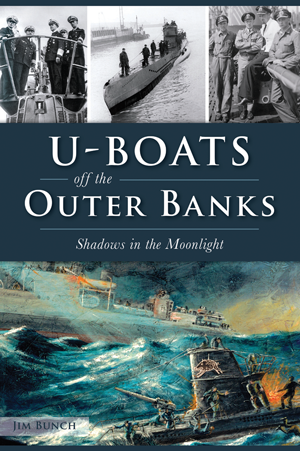
World War II was fought in nearly all corners of the globe, but few recall that North Carolina saw action in 1942, when German submarines arrived in the Outer Banks. Over seven months, seventy-five ships would sink off the unprotected coast of North Carolina at the hands of enemy U-boats.
While America’s ally Great Britain had been at war with Germany for two years, American support moved across the Atlantic Ocean. Germany, hoping to avoid engaging the United States, did not attack supply ships or American escorts of British ships. Hitler stood by his policy of nonaggression. But that changed in September of 1941.
“In the waters which we deem necessary for our defense, American naval vessels and American planes will no longer wait until Axis submarines lurking under the water, or Axis raiders on the surface of the sea, strike their deadly blow—first.” — President Roosevelt, September 11, 1941
Operation Drumbeat
Days following Japan’s surprise attack on Pearl Harbor, Hitler chose to declare war on the United States. Hitler’s team set their sites on the convoy lanes of the North Atlantic with an assault on America’s East Coast. North Carolina’s Cape Hatteras looked like a perfect strategic target, where U-boats could reach deep water and more than fifty ships a day moved to or from the Caribbean or the Gulf Coast. Five German subs set off for their quarry.

U-66
On January 18, 1942, just off the coast of Kitty Hawk, the tanker Allen Jackson, loaded with seventy-five thousand barrels of crude oil, was heading for New York City. Unknown to the crew and captain, they were headed directly toward the German submarine U-66. After stalking the tanker for three hours, U-66 launched two torpedoes toward the unsuspecting tanker, with both finding their mark. The explosion was seen by another U-boat over forty miles away, but, because the Allen Jackson was 70 miles from the coast of Hatteras Island, no Americans heard the noise or saw the explosions. Within thirty minutes, both halves of the ship were gone, and the sea was blazing from the ignited oil spill. The next day, U-66 struck the passenger liner Lady Hawkins.

U-432
Leaving Chile for Baltimore, the iron ore carrier Marore was fully-loaded and only able to travel at ten knots, making her an easy target for ambitious German subs. U-432, waiting there on the surface, lined up for the attack. The ship wasn’t completely destroyed with the U-boat’s last remaining torpedo, so the gun crew used their 88mm deck cannon to finish off the Marore. This would be the longest ship sunk.
Related: Hoosier WWII Hero Photographer John Bushemi
U-578
By February 22, when destroyers the Dickerson and the Jacob Jones were sent for anti-submarine duty, the U-578 waited. The Jones was hit with enough explosive force to blow the ship apart, and most of the 190-man crew were killed immediately. This was the second U.S. destroyer sunk by a U-boat since October 31, 1941. Still, no U-boats had yet been sunk in American waters.

By March, Eastern Sea Frontier defense had increased from five to fourteen destroyers, while thirteen German subs preyed on Allied ships off the North Carolina coast. More U-boats were ordered to arrive in April. Tanker losses along the East Coast of the United States had become so common that a convoy system of ships and escorts was implemented.
U-85
Smaller and more maneuverable, the German U-85 was used to siege convoys in the North Atlantic. On April 14, 1942, about fifteen miles east of Nags Head, the U-85 would meet its match. The destroyer USS Roper had a tactical advantage that previous destroyers did not: radar. The destroyer spotted an unidentified vessel, but an incoming torpedo quickly convinced them that they had engaged with a German U-boat. The U-85 was seen about three hundred yards ahead. With the water only one hundred feet deep, maneuvering was difficult for the submarine, so the crew fired their 88mm gun at the Roper. The destroyer returned fire with armor-piercing shells, and the U-85 sank in a matter of minutes, stern first. Was the sub scuttled? Either way, the U-85 was the first U-boat to be sunk by an American surface vessel in World War II.
Want to read more about German submarines in the Outer Banks? Check out U-Boats off the Outer Banks: Shadows in the Moonlight and other similar titles at arcadiapublishing.com!




